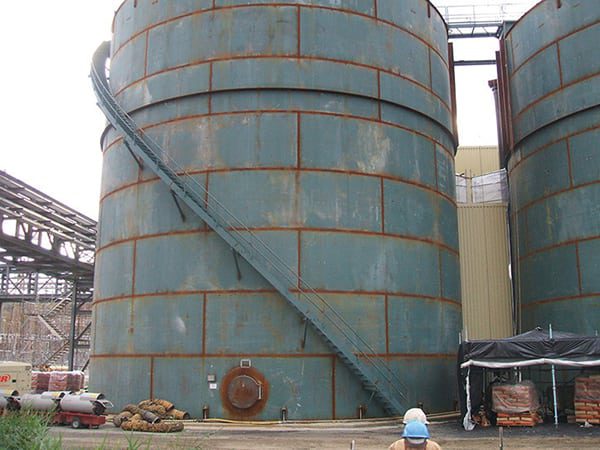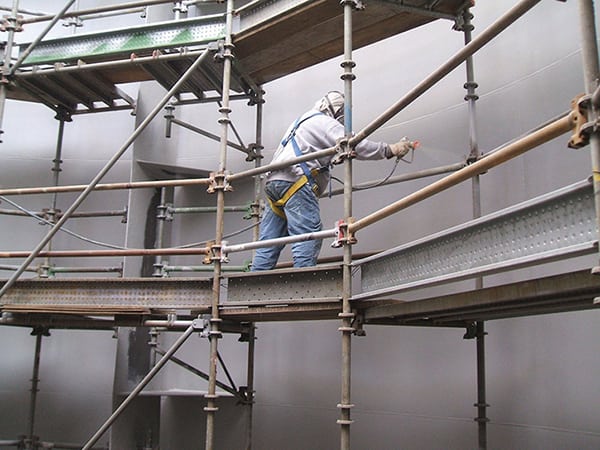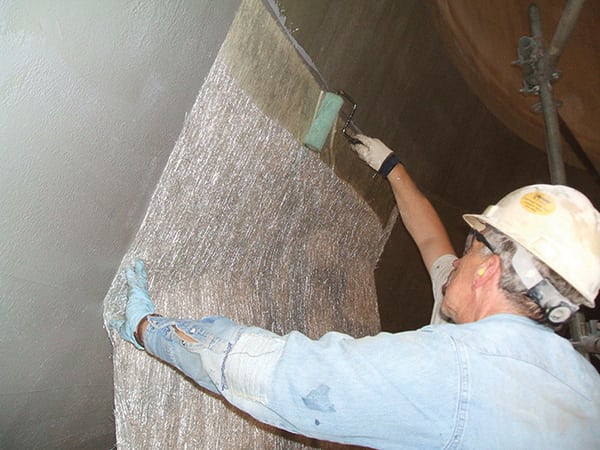Corrosion Protection for FGD Vessels
Roughly five years ago, the power industry readily embraced the new Alloy 2205 metal as a more lightweight and cost-effective substrate for the construction of flue gas desulfurization (FGD) absorbers and vessels than traditional heavy-duty stainless steel and carbon steel substrates, including the more common Alloys 304 and 316. Assuming that the surfaces of the Alloy 2205 FGD absorbers and vessels were properly prepared and lined, early test reports indicated that the substrate would hold up well, except perhaps under conditions such as crevice corrosion or corrosion under film buildup (Figure 7).
 |
| 7. Typical flue gas desulfurization vessel that will be lined to protect the substrate. Courtesy: International Paint |
New Substrate Gives Way to Old Corrosion Challenges
Prior to lining, Alloy 2205 requires a clean surface with a sharp profile and blast profile (depth). For most high-build linings or coatings, a 3-mil profile is needed. However, for most alloys, adjacent unlined surfaces also need to be protected during abrasive blasting to ensure that the surfaces are not contaminated by iron.
Because most slag abrasives contain iron, garnet or aluminum oxide abrasives are preferred choices, provided that they are able to produce the required sharp profile. As with carbon steel, the surface must be tested for salt contamination, and cleaned if necessary, to the lining manufacturer’s requirements. One different feature with alloys is that the surface must be coated or primed soon after blasting, unless dehumidification control holds the relative humidity to less than 40%, as the surface will not show the typical discoloration, as carbon steel does, due to surface oxidation.
Despite acceptable surface preparation and application of linings, many Alloy 2205 vessels located at more than 40 power plants across the U.S. are now showing evidence of severe pitting and corrosion under scale buildup, including “worm holing,” after just one year in service. Apparently, much of the pre-testing of Alloy 2205 did not take into consideration the effects of a high concentration of chlorides/fluorides under the scale buildup, or that it creates the same corrosive effects of crevice corrosion.
Not All Solutions Are Created Equal
Increased demand for corrosion-related repairs to Alloy 2205 vessels has given rise to some new corrosion solutions with varying degrees of efficacy.
One repair alternative used by plant owners is to clad the interior of the FGD vessel with an alloy metal that is known to perform well in these service conditions and costs less than other alloys, such as Alloy C276. Nevertheless, common drawbacks to this option include material availability. Alloy metal can often be in short supply, which forces owners to wait for extended periods until the material becomes available.
The biggest drawback to this repair solution, however, is cost. Between the high price of the material and the skilled welders needed for installation, some estimates put the cost of cladding up to $75 per square foot. Furthermore, localized leaks can still seep under the cladding and attack the alloy underneath virtually unnoticed. Worse, this repair process is fairly time-intensive, resulting in significant downtime, which some plants estimate at up to $1 million per day in lost revenues.
Over the past 10 years, vinyl ester linings have been the most common method of corrosion repair for both carbon steel vessels and many types of alloys. These linings can be very effective and are increasingly being utilized in Alloy 2205 corrosion repairs. Nevertheless, test data reveals that there are multiple variables within a lining system’s chemistry—even environmental factors—that can directly impact its long-term effectiveness—or failure—on Alloy 2205.
It’s All in the Chemistry
In order for an appropriate lining system to be properly specified for new vessel construction or repair, the plant owner and contractor must give the lining manufacturer a detailed list of the vessel’s operating conditions and the owner’s goals for usage. The list may include information like temperature variables, exact chemicals used, or function of the vessel. Factors such as temperature can affect differences in the permeation resistance of the material, while certain chemicals used inside the vessel may require a specific polymer base, such as an epoxy, epoxy novolac, polyester, chlorendic polyester, vinyl ester, novolac vinyl ester, or hybrid novolac.
In addition to the correct polymer base, an effective lining or coating requires the optimization of many other ingredients and elements, such as wetting agents, inhibitors, promoters, flexibilizers, and resins (Figure 8 and 9). Together, these formulations can make a huge impact on critical performance issues, including chemical and abrasion resistance, adhesion characteristics, application properties, crack-bridging capability, impact resistance, and even regulatory compliance. Most importantly, these lining formulations must undergo extensive laboratory testing and demonstrate effectiveness during actual in-service evaluation.
 |
| 8. An installer spraying Ceilcote lining onto tank walls. Courtesy: International Paint |
 |
| 9. An installer rolling fiberglass reinforcement into wet basecoat. Courtesy: International Paint |
Tying It All Together
Provided that the manufacturer’s test data meets the performance requirements of a given project, other factors, such as the cost of the installation and projected production downtime, will also play a big part in the project equation. That’s when the lining’s application characteristics, such as high-build single-coat options and fast cure rates, can help provide the most cost-effective and fastest return to service possible.
At about half the cost of alloy metal cladding, an appropriate lining system can be installed in just several days. Though other outside determinants—such as ease of access to the vessel, equipment and scaffolding, surface preparation, and onsite scheduling of trades—can delay the installation process, owners should expect a successful lining project to be completed within about two to six weeks and offer up to 30 years of service with only minor maintenance.
—Bill Slama ([email protected]) is a senior technical advisor with International Paint/Ceilcote Products.